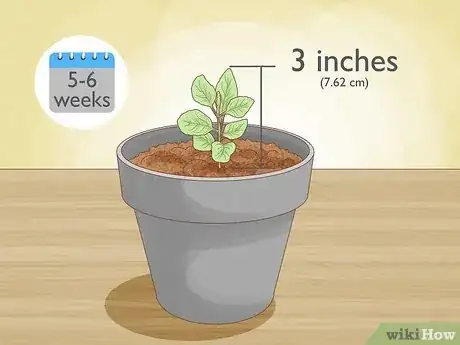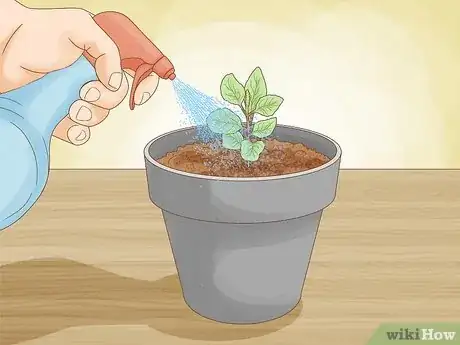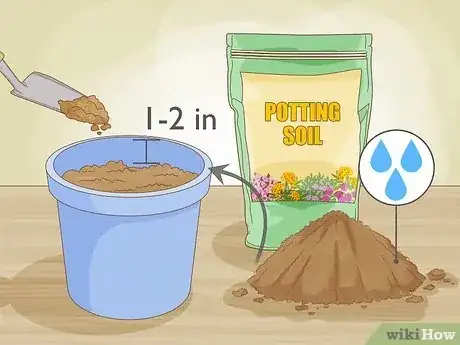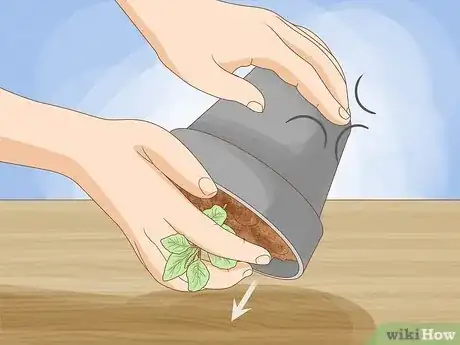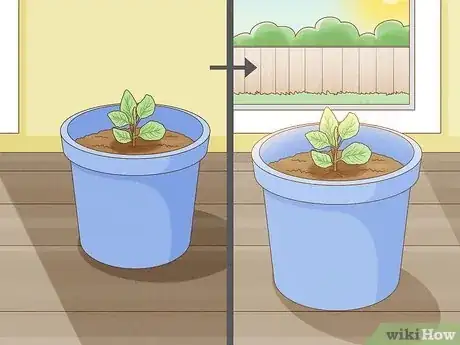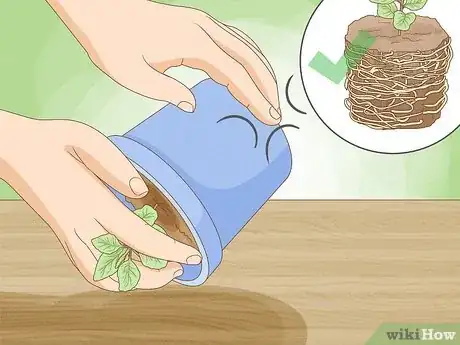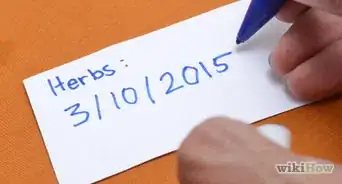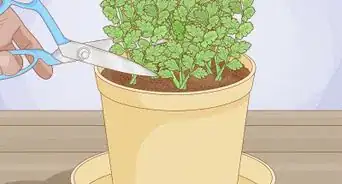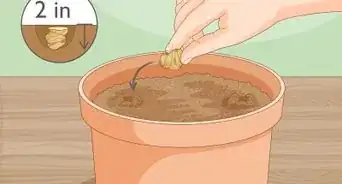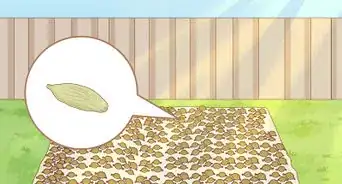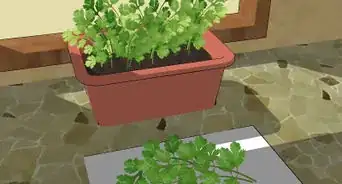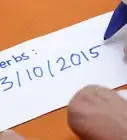This article was co-authored by Chai Saechao. Chai Saechao is the Founder and Owner of Plant Therapy, an indoor-plant store founded in 2018 based in San Francisco, California. As a self-described plant doctor, he believes in the therapeutic power of plants, hoping to keep sharing his love of plants with anyone willing to listen and learn.
This article has been viewed 58,209 times.
Having your own herb garden is a great asset to any home. Not only do the fresh herbs taste better, but you end up saving money by having spices right at your fingertips. Though it may seem daunting, growing and maintaining your herbs is simple. You can find the seeds for most herbs in any local grocery store, along with planters. Even the most difficult task, transplanting, is easy with the right tools and know-how.
Steps
Preparing to Transplant
-
1Make sure your herb seedlings are ready. Since transplanting the seedlings is hard on the plant, it's important to make sure they are strong enough to be moved. To check this, see if your herb seedlings have grown their “true leaves.” This should be the plants’ second set of leaves, which will be fuller and adult-like, as opposed to the thin and simple nature of their first set of leaves. They should appear after 5-6 weeks.[1]
- A good rule of thumb is to wait until your seedling is about 3-inches (7.62 cm) high.
- You should also make sure that your seedling is healthy. Check for yellow or curling leaves, or any other sign of weakness. Transplant only your healthy plants.
- You can also check to make sure the herb seedlings have formed a ball of roots, but this can be difficult to do without removing the plant from its pot or pellet.
-
2Water your herb seedlings. You should do this about two hours before you try to transplant your seedlings. You want the plants to be as strong as possible before being moved so they are more likely to grow once transplanted. The water will make sure the soil is loose and easy to break apart, which will help you transfer your seedlings quickly. Be careful to use just enough to make the soil moist.[2]Advertisement
-
3Put dirt in the pot you’ll be using. You should use moist potting soil and make sure you have enough room at the top for the seedling’s stem base to come up just below the top of the pot. This should be 1 to 2 inches below the pot’s rim depending on the size of your seedlings. You also want to make sure you aren't packing the soil. It shouldn’t be loose, but you don't want it compacted or it will be difficult for the roots to continue forming.
- You can also add rocks to the bottom of your pot to help drain the water. Good drainage is essential for many herbs, such as rosemary and sage.
- Try to stick to pots between 6”-8” for single plants and 10” and up for multiples. Make sure that your pots have drainage holes.
Transplanting Your Seedlings
-
1Remove your seedlings from their pots or pellets. If your seedlings are in a small planting pot, place your hand over the soil with the seedling in between your fingers. Then gently turn the pot upside down and shake it till the soil dislodges. However, if your seedlings are in pellets, simply peel off the skin around the soil.[3]
-
2Make a small hole in your potting soil. You can do this with your hands or a trowel. If you are planning to transplant more than one seedling, make sure you have enough space to make multiple holes without overcrowding the plants. Each hole should be deep enough for the seedling’s ball of roots.
- If you are unsure of how many seedlings to put in each pot, a common rule to remember is that a pot that is 8 inches or smaller should have only one plant, and one that is 10 inches or larger can have multiple plants.
-
3Put your seedlings into the hole. Once placed, move the soil back in over your seedling, and pat it down lightly. Remember, you want the soil tight, but not too compacted. You should also make sure that your seedling isn’t buried. You should be able to see its leaves and a little bit of its stem.
Finishing Up
-
1Water your seedlings. You want to water towards the base of your seedlings, since pouring water over their leaves can be damaging. You should also water them until you see some of it drain out of the bottom of your pot.
-
2Place your seedlings in shade first, then move to the sun. You don’t want to put them into direct sunlight until they adjust to their re-potting. Direct light and heat will damage the plant and may prevent it from growing. Instead, try gradually introducing the seedlings to sunlight a little at a time.[4]
-
3Check on your seedlings. Even after transplanting, you should make sure to check on the growth of your seedlings regularly. You want to make sure that the roots have grown and taken hold in the pot. You can try and check this by turning your plant’s pot on its side and gently tapping to dislodge the root ball. However, if your plant is showing positive signs of growth it is likely to have taken root in its new home.[5]
Expert Q&A
-
QuestionHow can I grow herbs indoors?
 Chai SaechaoChai Saechao is the Founder and Owner of Plant Therapy, an indoor-plant store founded in 2018 based in San Francisco, California. As a self-described plant doctor, he believes in the therapeutic power of plants, hoping to keep sharing his love of plants with anyone willing to listen and learn.
Chai SaechaoChai Saechao is the Founder and Owner of Plant Therapy, an indoor-plant store founded in 2018 based in San Francisco, California. As a self-described plant doctor, he believes in the therapeutic power of plants, hoping to keep sharing his love of plants with anyone willing to listen and learn.
Plant Specialist Herbs tend to be very delicate when you grow them indoors and you need to be more cautious about how you care for them. Do your research and make sure you understand how much light your specific herbs need. Also, do your best to keep the soil moist all the time.
Herbs tend to be very delicate when you grow them indoors and you need to be more cautious about how you care for them. Do your research and make sure you understand how much light your specific herbs need. Also, do your best to keep the soil moist all the time. -
QuestionHow do I transplant seeds that sprouted in paper towels? Can I plant them with the paper towel?
 Community AnswerStart with nice and damp soil. I wouldn't suggest leaving them in the paper towel. Place the sprouted seeds close to the soil's surface so that the sprout is near but not penetrating it.
Community AnswerStart with nice and damp soil. I wouldn't suggest leaving them in the paper towel. Place the sprouted seeds close to the soil's surface so that the sprout is near but not penetrating it.
Things You'll Need
- Herb seedlings
- Pots (terracotta, resin, wood, etc.)
- Trowel
- Potting soil
- Gardening gloves
- Water
References
- ↑ http://www.practicallyfunctional.com/how-to-transplant-seedlings-herb-garden/
- ↑ https://www.planetnatural.com/herb-gardening-guru/planting/
- ↑ http://www.bhg.com/gardening/vegetable/herbs/planting-potted-herbs/
- ↑ https://www.planetnatural.com/herb-gardening-guru/planting/
- ↑ http://www.logees.com/knowyourroots
- ↑ Chai Saechao. Plant Specialist. Expert Interview. 20 February 2019.
